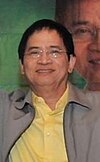Philippine presidential election, 2010
|
|
||||||||||||||||||||||||||||||||||||||||||||||||
|---|---|---|---|---|---|---|---|---|---|---|---|---|---|---|---|---|---|---|---|---|---|---|---|---|---|---|---|---|---|---|---|---|---|---|---|---|---|---|---|---|---|---|---|---|---|---|---|---|
|
||||||||||||||||||||||||||||||||||||||||||||||||
| Turnout | 74.34% |
|||||||||||||||||||||||||||||||||||||||||||||||
|
||||||||||||||||||||||||||||||||||||||||||||||||

Result according to the final congressional canvass.
|
||||||||||||||||||||||||||||||||||||||||||||||||
|
||||||||||||||||||||||||||||||||||||||||||||||||
Gloria Macapagal-Arroyo
Lakas-Kampi
The Philippine presidential and vice presidential elections of 2010 were held on Monday, May 10, 2010. The ruling President of the Philippines, Gloria Macapagal-Arroyo, was barred from seeking re-election by the 1987 Constitution, thus necessitating an election to select the 15th President.
Incumbent Vice-President Noli de Castro was allowed to seek re-election though he could have possibly sought the presidency. As he didn't offer himself in any manner of candidacy at the election, his successor was determined as the 15th Vice President of the Philippines. Although most presidential candidates have running mates, the president and vice president are elected separately, and the winning candidates may be of different political parties.
This election was also the first time that the Commission of Elections (COMELEC) implemented full automation of elections, pursuant to Republic Act 9369, "An act authorizing the Commission on Elections to use an Automated Election System in the May 11, 1998 National or Local Elections and in subsequent National And Local Electoral Exercises".
The results of the congressional canvassing showed that Senator Benigno Aquino III of the Liberal Party won by a plurality, although he had won with the highest percentage of votes since 1986, but not enough to have the largest margin of victory, even in elections held after 1986.
...
Wikipedia





